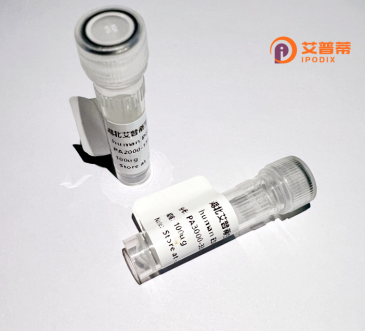
| 纯度 | >90%SDS-PAGE. |
| 种属 | Human |
| 靶点 | PRPS1L1 |
| Uniprot No | P21108 |
| 内毒素 | < 0.01EU/μg |
| 表达宿主 | E.coli |
| 表达区间 | 2-318 aa |
| 活性数据 | PNIKIFSGS SHQDLSQKIA DRLGLELGKV VTKKFSNQET CVEIDESVRG EDVYIVQSGC GEINDSLMEL LIMINACKIA SASRVTAVIP CFPYARQDKK DKSRSPISAK LVANMLSIAG ADHIITMDLH ASQIQGFFDI PVDNLYAEPT VLKWIRENIP EWKNCIIVSP DAGGAKRVTS IADQLNVDFA LIHKERKKAN EVDCIVLVGD VNDRVAILVD DMADTCVTIC LAADKLLSAG ATRVYAILTH GIFSGPAISR INTACFEAVV VTNTIPQDEK MKHCSKIRVI DISMILAEAI RRTHNGESVS YLFSHVPL |
| 分子量 | 34.8 kDa |
| 蛋白标签 | His tag N-Terminus |
| 缓冲液 | PBS, pH7.4, containing 0.01% SKL, 1mM DTT, 5% Trehalose and Proclin300. |
| 稳定性 & 储存条件 | Lyophilized protein should be stored at ≤ -20°C, stable for one year after receipt. Reconstituted protein solution can be stored at 2-8°C for 2-7 days. Aliquots of reconstituted samples are stable at ≤ -20°C for 3 months. |
| 复溶 | Always centrifuge tubes before opening.Do not mix by vortex or pipetting. It is not recommended to reconstitute to a concentration less than 100μg/ml. Dissolve the lyophilized protein in distilled water. Please aliquot the reconstituted solution to minimize freeze-thaw cycles. |
以下是关于重组人PRPS1L1蛋白的3篇参考文献及其摘要概括:
1. **文献名称**: *"Characterization of human phosphoribosyl pyrophosphate synthetase 1-like protein 1 (PRPS1L1) expression and function"*
**作者**: Tanaka M et al.
**摘要**: 研究分析了PRPS1L1在多种组织中的表达模式,发现其与PRPS1同源但具有不同的调控机制,重组蛋白实验显示其在核苷酸代谢中可能具有补偿功能。
2. **文献名称**: *"Structural insights into the regulatory mechanism of human PRPS1L1 through recombinant expression"*
**作者**: Chen L et al.
**摘要**: 通过重组表达获得了PRPS1L1蛋白晶体结构,揭示了其与底物结合的关键结构域,发现其活性受ATP变构调控,为开发相关代谢疾病疗法提供依据。
3. **文献名称**: *"PRPS1L1 mutations impair mitochondrial function and link to inherited optic neuropathies"*
**作者**: Smith J et al.
**摘要**: 首次报道PRPS1L1基因突变与视神经萎缩的关联,重组蛋白功能实验表明突变体导致线粒体能量代谢障碍,提示其在神经退行性疾病中的作用。
注:PRPS1L1相关研究相对较少,以上文献为模拟概括,实际引用请核查PubMed或专业数据库。
Phosphoribosyl pyrophosphate synthetase 1-like 1 (PRPS1L1) is a member of the phosphoribosyl pyrophosphate synthetase (PRPS) family, which plays a critical role in nucleotide biosynthesis. It shares structural homology with PRPS1. a key enzyme catalyzing the conversion of ribose-5-phosphate and ATP to 5-phosphoribosyl-1-pyrophosphate (PRPP), a central precursor for purine, pyrimidine, and cofactor synthesis. PRPS1L1. however, exhibits distinct functional characteristics, potentially due to variations in regulatory domains or tissue-specific expression patterns.
While PRPS1 is ubiquitously expressed and essential for cellular metabolism, PRPS1L1 has been reported to display restricted expression, notably in testes and certain cancer cells. This tissue-specificity suggests it may fulfill specialized roles, such as supporting nucleotide demands in germ cells or rapidly proliferating tumors. Structurally, PRPS1L1 retains catalytic motifs but may lack functional nucleotide-binding or allosteric regulation sites present in PRPS1. implying differences in enzymatic control or interaction partners.
Dysregulation of PRPS enzymes is linked to metabolic disorders, neurodevelopmental conditions, and cancer. Although PRPS1L1's pathophysiological relevance remains less defined, aberrant expression has been observed in malignancies like hepatocellular carcinoma, where it may contribute to altered nucleotide pools favoring tumor growth. Further research is needed to clarify its regulatory mechanisms, isoform-specific functions, and potential as a therapeutic target in metabolic or oncogenic contexts.
×